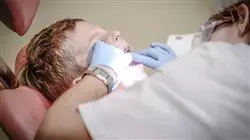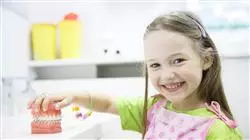University certificate
The world's largest faculty of dentistry”
Introduction to the Program
Thanks to this Professional master’s degree you will get the up-to-date knowledge in Pediatric Dentistry you were looking for"

Patients with special dental care needs encounter numerous challenges for adequate, tailored dental care and treatment. It is an important population group, as well as that of children who need highly qualified professionals. This Professional master’s degree in Updated Pediatric Dentistry delves into the main aspects that make up pediatric dentistry oral care in children, from birth to 14 years of age.
An update that the dental professional will achieve throughout this 12-month program, thanks to the educational content provided by a large teaching team specialized in this field. Their extensive knowledge and extensive experience in oral care and intervention in children will be reflected in multimedia material consisting of video summaries, videos in detail, essential readings and clinical case scenarios that will be very useful in the development of this program.
A program where the professional will delve into the structures of the mouth, its functioning, the establishment of a dental home, the accompaniment of the child and their family, the care and maintenance of a healthy mouth, the recognition of the various pathologies that can occur in the oral and dental area. In addition, this program will help students to be aware of the latest developments in treatments, especially in children who require special dental care.
A 100% online Professional master’s degree that gives students the flexibility of being able to study a university program, wherever and whenever they wish. It only requires an electronic device with internet connection to access the complete syllabus, without attendance or fixed schedules. This allows you to distribute the teaching load according to your needs, without neglecting other areas of your personal or professional life. An excellent opportunity offered to dental professionals who want to update their knowledge through a high-level educational program.
Download content from the multimedia resource library and access it when you need it"
This Professional master’s degree in Updated Pediatric Dentistry contains the most complete and up-to-date scientific program on the market. The most important features include:
- More than 75 clinical cases presented by experts in comprehensive pediatric dentistry. The graphic, schematic, and eminently practical contents with which they are created provide scientific and practical information on the disciplines that are essential for professional
- Diagnostic-therapeutic developments on assessment, diagnosis, and treatment in comprehensive pediatric dentistry
- It contains practical exercises where the self-evaluation process can be carried out to improve learning
- Iconography of clinical and diagnostic imaging tests
- An algorithm-based interactive learning system for decision-making in the clinical situations presented throughout the course
- With special emphasis on evidence-based medicine and research methodologies in comprehensive pediatric dentistry
- All this will be complemented by theoretical lessons, questions to the expert, debate forums on controversial topics, and individual reflection assignments
- Content that is accessible from any fixed or portable device with an Internet connection
Over 12 months you will learn in depth about the main techniques in Pediatric Dentistry. All this online and with the most up-to-date content"
The teaching staff includes professionals from the field of comprehensive pediatric dentistry, who bring their experience to this training program, as well as renowned specialists from leading scientific societies.
The multimedia content developed with the latest educational technology will provide the professional with situated and contextual learning, i.e., a simulated environment that will provide an immersive training program to train in real situations.
This program is designed around Problem Based Learning, whereby the student will must try to solve the different professional practice situations that arise during the course. For this purpose, the dentist will be assisted by an innovative interactive video system created by renowned and experienced experts in the field of comprehensive pediatric dentistry with extensive teaching experience.
It provides an in-depth study of the surgical preoperative period in Pediatric Dentistry and the main techniques applied in dental restoration"

An educational program in which you will delve into oral care and the latest studies on dental trauma"
Why study at TECH?
TECH is the world’s largest online university. With an impressive catalog of more than 14,000 university programs available in 11 languages, it is positioned as a leader in employability, with a 99% job placement rate. In addition, it relies on an enormous faculty of more than 6,000 professors of the highest international renown.

Study at the world's largest online university and guarantee your professional success. The future starts at TECH”
The world’s best online university according to FORBES
The prestigious Forbes magazine, specialized in business and finance, has highlighted TECH as “the world's best online university” This is what they have recently stated in an article in their digital edition in which they echo the success story of this institution, “thanks to the academic offer it provides, the selection of its teaching staff, and an innovative learning method aimed at educating the professionals of the future”
A revolutionary study method, a cutting-edge faculty and a practical focus: the key to TECH's success.
The most complete study plans on the university scene
TECH offers the most complete study plans on the university scene, with syllabuses that cover fundamental concepts and, at the same time, the main scientific advances in their specific scientific areas. In addition, these programs are continuously being updated to guarantee students the academic vanguard and the most in-demand professional skills. In this way, the university's qualifications provide its graduates with a significant advantage to propel their careers to success.
TECH offers the most comprehensive and intensive study plans on the current university scene.
A world-class teaching staff
TECH's teaching staff is made up of more than 6,000 professors with the highest international recognition. Professors, researchers and top executives of multinational companies, including Isaiah Covington, performance coach of the Boston Celtics; Magda Romanska, principal investigator at Harvard MetaLAB; Ignacio Wistumba, chairman of the department of translational molecular pathology at MD Anderson Cancer Center; and D.W. Pine, creative director of TIME magazine, among others.
Internationally renowned experts, specialized in different branches of Health, Technology, Communication and Business, form part of the TECH faculty.
A unique learning method
TECH is the first university to use Relearning in all its programs. It is the best online learning methodology, accredited with international teaching quality certifications, provided by prestigious educational agencies. In addition, this disruptive educational model is complemented with the “Case Method”, thereby setting up a unique online teaching strategy. Innovative teaching resources are also implemented, including detailed videos, infographics and interactive summaries.
TECH combines Relearning and the Case Method in all its university programs to guarantee excellent theoretical and practical learning, studying whenever and wherever you want.
The world's largest online university
TECH is the world’s largest online university. We are the largest educational institution, with the best and widest online educational catalog, one hundred percent online and covering the vast majority of areas of knowledge. We offer a large selection of our own degrees and accredited online undergraduate and postgraduate degrees. In total, more than 14,000 university degrees, in eleven different languages, make us the largest educational largest in the world.
TECH has the world's most extensive catalog of academic and official programs, available in more than 11 languages.
Google Premier Partner
The American technology giant has awarded TECH the Google Google Premier Partner badge. This award, which is only available to 3% of the world's companies, highlights the efficient, flexible and tailored experience that this university provides to students. The recognition as a Google Premier Partner not only accredits the maximum rigor, performance and investment in TECH's digital infrastructures, but also places this university as one of the world's leading technology companies.
Google has positioned TECH in the top 3% of the world's most important technology companies by awarding it its Google Premier Partner badge.
The official online university of the NBA
TECH is the official online university of the NBA. Thanks to our agreement with the biggest league in basketball, we offer our students exclusive university programs, as well as a wide variety of educational resources focused on the business of the league and other areas of the sports industry. Each program is made up of a uniquely designed syllabus and features exceptional guest hosts: professionals with a distinguished sports background who will offer their expertise on the most relevant topics.
TECH has been selected by the NBA, the world's top basketball league, as its official online university.
The top-rated university by its students
Students have positioned TECH as the world's top-rated university on the main review websites, with a highest rating of 4.9 out of 5, obtained from more than 1,000 reviews. These results consolidate TECH as the benchmark university institution at an international level, reflecting the excellence and positive impact of its educational model.” reflecting the excellence and positive impact of its educational model.”
TECH is the world’s top-rated university by its students.
Leaders in employability
TECH has managed to become the leading university in employability. 99% of its students obtain jobs in the academic field they have studied, within one year of completing any of the university's programs. A similar number achieve immediate career enhancement. All this thanks to a study methodology that bases its effectiveness on the acquisition of practical skills, which are absolutely necessary for professional development.
99% of TECH graduates find a job within a year of completing their studies.
Professional Master's Degree in Updated Pediatric Dentistry
Due to the nature, effectiveness and adaptability of its procedures, dental care for pediatric patients stands out as one of the most relevant fields of dentistry in recent years, and there is currently a great demand for the development of its procedures and intervention techniques. This situation has generated a growing interest, on the part of public and private dental clinics, for the labor insertion of professionals specialized in this field. Understanding academic updating as an element of great relevance for an adequate occupational performance in the area, at TECH Global University we have prepared our Master's program in Updated Pediatric Dentistry. In this postgraduate course, special attention will be paid to the knowledge of new materials, products and systems used in the therapeutic remineralization of incipient caries lesions. Likewise, the following topics will be updated: knowledge of the different treatment alternatives used in the approach to orofacial soft tissue lesions; and the identification of the different measures for mechanical and chemical control of the dentobacterial plaque in a pediatric patient.
Study an online Professional Master's Degree in Updated Pediatric Dentistry
The proper management of pediatric patients in the field of dentistry requires, in the professional in charge, a series of practical and communicative skills and abilities that can only be acquired through the approach of a high quality training program. In our Master's program you will approach pediatric dentistry from the identification of new preventive, diagnostic and therapeutic alternatives that accompany the processes of development and evolution of the area. Likewise, in this postgraduate program you will delve into the modernization of the following aspects: the identification of the main antibiotic, anti-inflammatory and analgesic drugs applied in the area of pediatric dentistry; and the adequate practical and protocol management of the dental care processes applied in infants.







